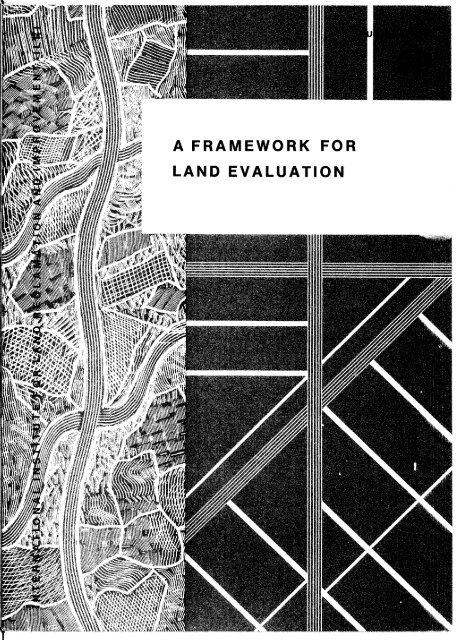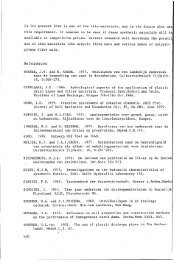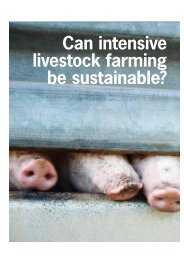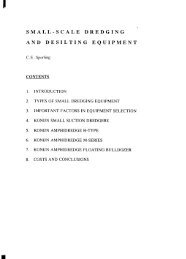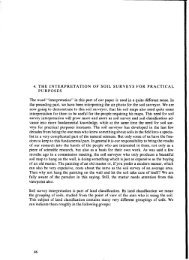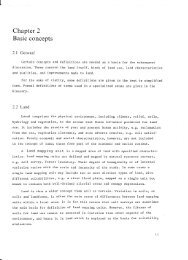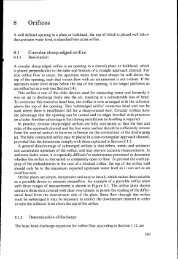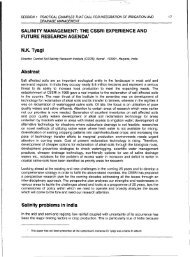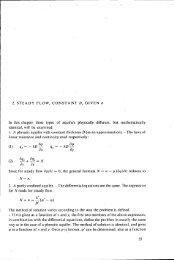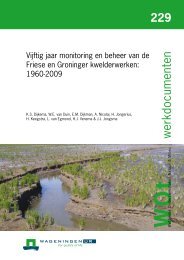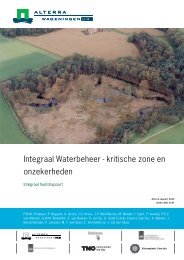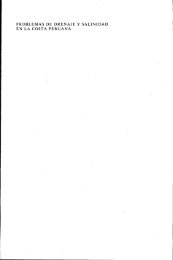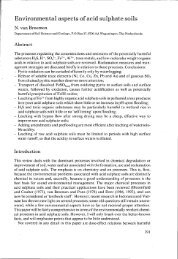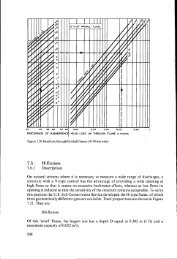A FRAMEWORK FOR LAND EVALUATION - ROOT of content
A FRAMEWORK FOR LAND EVALUATION - ROOT of content
A FRAMEWORK FOR LAND EVALUATION - ROOT of content
Create successful ePaper yourself
Turn your PDF publications into a flip-book with our unique Google optimized e-Paper software.
A <strong>FRAMEWORK</strong> <strong>FOR</strong><br />
<strong>LAND</strong> <strong>EVALUATION</strong>
A <strong>FRAMEWORK</strong> <strong>FOR</strong> <strong>LAND</strong> <strong>EVALUATION</strong>
c<br />
t<br />
A <strong>FRAMEWORK</strong> <strong>FOR</strong> <strong>LAND</strong> <strong>EVALUATION</strong><br />
Soil Resources Development and Conservation Service<br />
Land and Water Development Division<br />
Food and Agriculture Organization<br />
<strong>of</strong> the United Nations<br />
Published by arrangement with the<br />
FOOD AND AGRICULTURE ORGANIZATION<br />
OF THE UNITED NATIONS<br />
INTERNATIONAL INSTITUTE <strong>FOR</strong> <strong>LAND</strong> RECLAMATION AND IMPROVEMENT/ILRI<br />
P.O. BOX 45 WAGENINGEN THE NETHER<strong>LAND</strong>S 1977
c<br />
The designations employed and the presentation <strong>of</strong> material in this publication do not imply the<br />
expression <strong>of</strong> any opinion whatsoever on the part <strong>of</strong> the Food and Agriculture Organization <strong>of</strong> the<br />
United Nations concerning the legal status <strong>of</strong> any country, territory, city or area or <strong>of</strong> its authorities.<br />
or concerning the delimitation <strong>of</strong> its frontiers or boundaries.<br />
This book is published as :<br />
FAO Soils Bulletin No. 32<br />
ILRI Publication No. 22<br />
The copyright in this book is vested in the Food and Agriculture Organization <strong>of</strong> the United Nations.<br />
The book may not be reproduced, in whole or in part, by any method or process, without written<br />
permission from the copyright holder. Applications for such permission, with a statement <strong>of</strong> the<br />
purpose and extent <strong>of</strong> the reproduction desired, should be addressed to the Director, Pubhcations<br />
Division, Food and Agriculture Organization’ <strong>of</strong> the United Nations, Via delle Terme di Caracalla,<br />
OOI00 Rome, Italy.<br />
t:) FAO 1976
k<br />
c<br />
Preface<br />
By 1970 many countries had developed their own systems <strong>of</strong> land evaluation.<br />
This made exchange <strong>of</strong> information difficult,and there was a clear need for inter-<br />
national discussion to achieve some form <strong>of</strong> standardization. ' Preparatory work<br />
undertaken by two committees, one in The Netherlands and one in FAO, led to the<br />
production <strong>of</strong> a background document (FAO, 1972). This document, together with<br />
papers describing land classification systems throughout the world (FAO, 1974),<br />
was discussed at a meeting <strong>of</strong> international experts held in Wageningen in October<br />
1972. Agreement was reached on most <strong>of</strong> the principles <strong>of</strong> the proposed framework<br />
for land evaluation, and a summary <strong>of</strong> the discussions and recommendations <strong>of</strong> the<br />
meeting was published (Brinkman and Smyth, 1973).<br />
The next stage was the writing <strong>of</strong> the first draft <strong>of</strong> a Framework (FAO, 1973).<br />
This was widely circulated with a request for comments. In the light <strong>of</strong> these<br />
comments a smaller meeting was held in Rome in January 1975, in which gaps in<br />
the draft Framework were identified and suggestions made for improvement. The<br />
discussions and recommendations <strong>of</strong> this second meeting (FA0,1975) form the basis<br />
from which the present document has been prepared.<br />
A large number <strong>of</strong> experts in land evaluation, both within FAO and from many<br />
different countries, have contributed to or commented upon the present text.<br />
Major contributions to the development <strong>of</strong> the concepts and methods incorporated<br />
in the Framework have been made by K.J.Beek, J.Bennema, P.J.Mahler and A.J.Smyth<br />
In particular the concepts <strong>of</strong> land utilization types,land qualities and matching<br />
owe much to the work <strong>of</strong> K.J.Beek and J.Bennema (1971).<br />
Others who have contri-<br />
buted to the development <strong>of</strong> methods, or supplied material, include C.A.Robertson<br />
and A.P.A.Vink. Extensive and valuable comments on the draft text have been<br />
received from participants in the 1975 meeting, also from M.Ashraf and J.H.de<br />
Vos t.N.C. The present text has been edited by R.Brinkman and A.Young.<br />
Land evaluation is designed to serve practical purposes. The Framework, in<br />
its draft versions,has already been employed in a number <strong>of</strong> FAO land development<br />
projects.It is essential that it should now be extensively tested,by application<br />
to a wide variety <strong>of</strong> environments, physical, economic and social, and to a broad<br />
range <strong>of</strong> planning purposes. It is only by such practical applications that the<br />
Framework can serve its intended purpose: to contribute to the wise use <strong>of</strong> land<br />
resources by man.<br />
l'wo new systems, one developed in Iran m d one in BraziZ, drew attention to<br />
possibilities in this regard.<br />
V
/<br />
Contents<br />
CHAPTER 1<br />
THE NATURE AND PRINCIPLES OF <strong>LAND</strong> <strong>EVALUATION</strong><br />
1.1<br />
1.2<br />
1.3<br />
1.4<br />
1.5<br />
1.6<br />
General<br />
The aims <strong>of</strong> land evaluation<br />
Land evaluation and land use planning<br />
Principles<br />
Levels <strong>of</strong> intensity and approaches<br />
1.5.1 Levels <strong>of</strong> intensity<br />
1.5.2 Two-stage and parallel approaches<br />
to land evaluation<br />
The nature <strong>of</strong> the Framework<br />
6<br />
8<br />
CHAPTER 2<br />
BASIC CONCEPTS<br />
2.1<br />
2.2<br />
2.3<br />
2.4<br />
2.5<br />
2.6<br />
2.7<br />
General 11<br />
Land 11<br />
Land use 12<br />
2.3.1 Major kinds <strong>of</strong> land use and land utilization types 12<br />
2.3.2 Multiple and compound land use 14<br />
Land characteristics, land qualities and diagnostic<br />
criteria 14<br />
2.4.1 Examples<br />
2.4.2 The scarcity value <strong>of</strong> land<br />
Requirements and limitations 18<br />
Land improvements<br />
19<br />
Land suitability and land capability<br />
20<br />
17<br />
18<br />
CHAPTER 3<br />
<strong>LAND</strong> SUITABILITY CLASSIFICATIONS<br />
3.1 General<br />
3.2 Structure <strong>of</strong> the suitability classification<br />
3.2.1 Land Suitability Orders<br />
3.2.2 Land Suitability Classes<br />
3.2.3 Land Suitability Subclasses<br />
3.2.4 Land Suitability Units<br />
3.2.5 Conditional Suitability<br />
3.2.6 Summary<br />
21<br />
21<br />
22<br />
22<br />
25<br />
25<br />
26<br />
27<br />
vi
t<br />
3.3 The range <strong>of</strong> classifications<br />
3.3.1 Qualitative and quantitative classifications<br />
3.3.2 Classifications <strong>of</strong> current and potential<br />
suitability<br />
3.4 The results <strong>of</strong> land suitability evaluation<br />
27<br />
28<br />
28<br />
29<br />
CHAPTER 4<br />
<strong>LAND</strong> <strong>EVALUATION</strong> PROCEDURES<br />
4.1<br />
4.2<br />
4.3<br />
4.4<br />
4.5<br />
4.6<br />
4.7<br />
4.8<br />
4.9<br />
General<br />
Initial consultations<br />
4.2.1 Objectives<br />
4.2.2 The context <strong>of</strong> the study area<br />
4.2.3<br />
4.2.4<br />
Data and assumptions underlying the evaluation<br />
Planning the evaluation<br />
Kinds <strong>of</strong> land use and their requirements and limitations<br />
4.3.1 Description <strong>of</strong> kinds <strong>of</strong> land use<br />
4.3.2 Identification <strong>of</strong> requirements <strong>of</strong> the use and<br />
limitations<br />
Description <strong>of</strong> land mapping units and land qualities<br />
Comparison <strong>of</strong> land use with land<br />
4.5.1 Matching <strong>of</strong> land use with land<br />
4.5.2 Diagnostic procedures<br />
4.5.3 Estimation <strong>of</strong> benefits and inputs<br />
4.5.4 Assessment <strong>of</strong> environmental impact<br />
Economic and social analysis<br />
Land suitability classification<br />
4.7.1 The field check<br />
Synopsis <strong>of</strong> procedures<br />
Presentation <strong>of</strong> results<br />
33<br />
35<br />
35<br />
37<br />
37<br />
39<br />
41<br />
41<br />
42<br />
43<br />
43<br />
44<br />
45<br />
47<br />
48<br />
49<br />
51<br />
51<br />
54<br />
54<br />
CHAPTER 5<br />
EXAMPLES<br />
5.1 General<br />
5.2 Land uses and land qualities in Brazil<br />
5.2.1 Description <strong>of</strong> the land utilization types<br />
5.2.2 Example <strong>of</strong> a land quality: limitations to<br />
mechanization<br />
5.2.3 Suitability description <strong>of</strong> a land mapping unit<br />
57<br />
58<br />
58<br />
60<br />
63<br />
vii
5.3<br />
5.4<br />
5.5<br />
Smallholders' oil palm cultivation in Surinam<br />
5.3.1 Description <strong>of</strong> land use (data and assumptions)<br />
5.3.2 Social and economic context<br />
5.3.3 Required land qualities<br />
5.3.4 Composition <strong>of</strong> the main land qualities<br />
5.3.5 Land suitability classification<br />
Land utilization types in Kenya<br />
5.4.1 Smallholders rainfed arable farming: traditional<br />
technology<br />
Location as a land quality<br />
64<br />
64<br />
65<br />
65<br />
66<br />
70<br />
71<br />
74<br />
77<br />
Glossary<br />
Ref erences<br />
81<br />
85<br />
LIST OF TABLES<br />
I.<br />
2.<br />
3.<br />
4.<br />
5.<br />
6.<br />
7.<br />
8.<br />
9.<br />
IO.<br />
11.<br />
Examples <strong>of</strong> land qualities<br />
Structure <strong>of</strong> the suitability classification<br />
Tabular legends to land suitability maps<br />
Degrees <strong>of</strong> limitation for mechanization in Brazil<br />
Some important land qualities in Surinam<br />
Criteria and ratings for moisture availability<br />
Criteria and ratings for oxygen availability in<br />
the root zone<br />
Criteria and ratings for nutrient availability<br />
Criteria and ratings for trafficability and for<br />
access ib i1 i ty<br />
Quantifiable factors for each land utilization type<br />
in Eastern Province, Kenya<br />
Road classification and transport cost index in Japan<br />
16<br />
27<br />
55<br />
63<br />
66<br />
67<br />
68<br />
69<br />
70<br />
72<br />
79<br />
LIST OF FIGURES<br />
1. Two-stage and parallel approaches to land evaluation 7<br />
2. Examples <strong>of</strong> qualitative land suitability maps 31<br />
3. Schematic representation <strong>of</strong> activities in land<br />
evaluation 34<br />
4. Two-stage approach to land evaluation<br />
52<br />
5. Parallel approach to land evaluation<br />
53<br />
viii
Chapter 1<br />
The nature and principles <strong>of</strong> land evaluation<br />
I. 1 Genel-al<br />
Decisions on land use have always been part <strong>of</strong> the evolution <strong>of</strong> human<br />
society. In the past,land use changes <strong>of</strong>ten came about by gradual evolution,as<br />
the result <strong>of</strong> many separate decisions taken by individualS.In the more crowded<br />
and complex world <strong>of</strong> the present they are frequently brought about by the process<br />
<strong>of</strong> land use planning. Such planning takes place in all parts <strong>of</strong> the world,including<br />
both developing and developed countries. It may be concerned with putting<br />
environmental resources to new kinds <strong>of</strong> productive use. The need for land use<br />
planning is frequently brought about, however, by changing needs and pressures,<br />
involving competing uses for the same land.<br />
The function <strong>of</strong> land use planning is to guide decisions on land use in such<br />
a way that the resources <strong>of</strong> the environment are put to the most beneficial use<br />
for man, whilst at the same time conserving those resources for the future. This<br />
planning must be based on an understanding both <strong>of</strong> the natural environment and<br />
<strong>of</strong> the kinds <strong>of</strong> land use envisaged. There have been many examples <strong>of</strong> damage to<br />
natural resources and <strong>of</strong> unsuccessful land use enterprises through failure to<br />
take account <strong>of</strong> the mutual relationships between land and the uses to which it is<br />
put. It is a function <strong>of</strong> land evaluation to bring about such understanding and to<br />
present planners with comparisons <strong>of</strong> the most promising kinds <strong>of</strong> land use.<br />
Land evaluation is concerned with the assessment <strong>of</strong> land performance when<br />
used for specified purposes. It involves the execution and interpretation <strong>of</strong><br />
basic surveys <strong>of</strong> climate, soils, vegetation and other aspects <strong>of</strong> land in terms<br />
<strong>of</strong> the requirements <strong>of</strong> alternative forms <strong>of</strong> land use. To be <strong>of</strong> value in planning,<br />
the range <strong>of</strong> land uses considered has to be limited to those which are relevant<br />
within the physical, economic and social context <strong>of</strong> the area considered, and the<br />
comparisons must incorporate economic considerations.<br />
1 .2 Tlic aims <strong>of</strong> land evaluation<br />
Land evaluation may be concerned with present land performance. Frequently,<br />
however, it involves change and its effects: change in the use <strong>of</strong> land and in<br />
some cases change in the land itself.<br />
1
Evaluation takes into consideration the economics <strong>of</strong> the proposed enter-<br />
prises, the social consequences for the people <strong>of</strong> the area and the country con-<br />
cerned, and the consequences, beneficial or adverse, for the environment. Thus<br />
land evaluation should answer the following questions:<br />
- How is the land currently managed, and what will happen if present<br />
practices remain unchanged?<br />
- What improvements in management practices, within the present use,<br />
are possible?<br />
-<br />
What other uses <strong>of</strong> land are physically possible and economically<br />
and socially relevant?<br />
- Which <strong>of</strong> these uses <strong>of</strong>fer possibilities <strong>of</strong> sustained production or<br />
other benefits?<br />
- What adverse effects, physical, economic or social, are associated<br />
with each use?<br />
- What recurrent inputs are necessary to bring about the desired<br />
production and minimize the adverse effects?<br />
- What are the benefits <strong>of</strong> each form <strong>of</strong> use?<br />
If the introduction <strong>of</strong> a new use involves significant change in the land<br />
itself, as for example in irrigation schemes, then the following additional<br />
questions should be answered:<br />
- What changes in the condition <strong>of</strong> the land are feasible and<br />
necessary, and how can they be brought about?<br />
- What non-recurrent inputs are necessary to implement<br />
these changes?<br />
The evaluation process does not in itself determine the land use changes<br />
that are to be carried out, but provides data on the basis <strong>of</strong> which such decisions<br />
can be taken. To be effective in this role, the output from an evaluation<br />
normally gives information on two or more potential forms <strong>of</strong> use for each area<br />
<strong>of</strong> land, including the consequences, beneficial and adverse, <strong>of</strong> each.<br />
1.3 Land evaluation and land use planning<br />
Land evaluation is only part <strong>of</strong> the process <strong>of</strong> land use planning.Its precise<br />
role varies in different circumstances.1n the present context it is sufficient to<br />
2
epresent the land use planning process by the following generalized sequence<br />
<strong>of</strong> activities and decisions:<br />
1.<br />
ii.<br />
...<br />
111.<br />
iv.<br />
V.<br />
vi.<br />
vii.<br />
recognition <strong>of</strong> a need for change;<br />
identification <strong>of</strong> aims;<br />
formulation <strong>of</strong> proposals, involving alternative forms <strong>of</strong> land use,<br />
and recognition <strong>of</strong> their main requirements;<br />
recognition and delineation <strong>of</strong> the different types <strong>of</strong> land present<br />
in the area;<br />
comparison and evaluation <strong>of</strong> each type <strong>of</strong> land for the different<br />
uses;<br />
selection <strong>of</strong> a preferred use for each type <strong>of</strong> land;<br />
project design, or other detailed analysis <strong>of</strong> a selected set <strong>of</strong><br />
alternatives for distinct parts <strong>of</strong> the area - this, in certain<br />
cases, may take the form <strong>of</strong> a feasibility study;<br />
viii. decision to implement;<br />
ix.<br />
implementation;<br />
x. monitoring <strong>of</strong> the operation.<br />
Land evalution plays a major part in stages iii, iv and v <strong>of</strong> the above<br />
sequence, and contributes information to the subsequent activities. Thus land<br />
evaluation is preceded by the recognition <strong>of</strong> the need for some change in the use<br />
to which land is put; this may be the development <strong>of</strong> new productive uses, such<br />
as agricultural development schemes or forestry plantations, or the provision <strong>of</strong><br />
services, such as the designation <strong>of</strong> a national park or recreational area.<br />
Recognition <strong>of</strong> this need is followed by identification <strong>of</strong> the aims <strong>of</strong> the<br />
proposed change and formulation <strong>of</strong> general and specific proposals.The evaluation<br />
process itself includes description <strong>of</strong> a range <strong>of</strong> promising kinds <strong>of</strong> use, and<br />
the assessment and comparison <strong>of</strong> these with respect to each type <strong>of</strong> land identified<br />
in the area. This leads to recommendations involving one or a small number<br />
<strong>of</strong> preferred kinds <strong>of</strong> use. These recommendations can then be used in making decisions<br />
on the preferred kinds <strong>of</strong> land use for each distinct part <strong>of</strong> the area.<br />
Later stages will usually involve further detailed analysis <strong>of</strong> the preferred<br />
uses, followed, if the decision to go ahead is made, by the implementation <strong>of</strong><br />
the development project or other form <strong>of</strong> change,and monitoring <strong>of</strong> the resulting<br />
systems.<br />
3
k<br />
1.4 Principles<br />
Certain principles are fundamental to the approach and methods employed in<br />
land evaluation. These basic principles are as follows:<br />
i. Land suitability is assessed and classified with respect<br />
to specified kinds <strong>of</strong> use<br />
This principle embodies recognition <strong>of</strong> the fact that different kinds<br />
<strong>of</strong> land use have different requirements. As an example, an alluvial<br />
floodplain with impeded drainage might be highly suitable for rice<br />
cultivation but not suitable for many forms <strong>of</strong> agriculture or for<br />
forestry.<br />
The concept <strong>of</strong> land suitability is only meaningful in terms <strong>of</strong> specific<br />
kinds <strong>of</strong> land use, each with their own requirements, e.g. for<br />
soil moisture, rooting depth etc.The qualities <strong>of</strong> each type <strong>of</strong> land,<br />
such as moisture availability or liability to flooding, are compared<br />
with the requirements <strong>of</strong> each use. Thus the land itself and the land<br />
use are equally fundamental to land suitability evaluation.<br />
ii.<br />
EvuZuation requires a comparison <strong>of</strong> the benefits obtained and the<br />
inputs needed on different types <strong>of</strong> land<br />
Land in itself, without inputs, rarely if ever possesses productive<br />
potential; even the collection <strong>of</strong> wild fruits requires labour,whilst<br />
the use <strong>of</strong> natural wilderness for nature conservation requires<br />
measures for its protection. Suitability for each use is assessed by<br />
comparing the required inputs, such as labour, fertilizers or road<br />
construction, with the goods produced or other benefits obtained.<br />
...<br />
zzz. A muZtidiscipZinary approach is required<br />
The evaluation process requires contributions from the fields <strong>of</strong><br />
natural science, the technology <strong>of</strong> land use, economics and sociology.<br />
In particular, suitability evaluation always incorporates economic<br />
considerations to a greater or lesser extent. In qualitative evaluation,<br />
economics may be employed in general terms only, without<br />
calculation <strong>of</strong> costs and returns. In quantitative evaluation the<br />
comparison <strong>of</strong> benefits and inputs in economic terms plays a major<br />
part in the determination <strong>of</strong> suitability.<br />
It follows that a team carrying out an evaluation requires a range<br />
<strong>of</strong> specialists. These will usually include natural scientists (e.g.<br />
geomorphologists, soil surveyors, ecologists), specialists in the<br />
technology <strong>of</strong> the forms <strong>of</strong> land use under consideration (e.g. agronomists,<br />
foresters, irrigation engineers, experts in livestock<br />
management), economists and sociologists. There may need to be some<br />
combining <strong>of</strong> these functions for practical reasons,but the principle<br />
<strong>of</strong> multidisciplinary activity, encompassing studies <strong>of</strong> land, land<br />
use, social aspects and economics, remains.<br />
4
k<br />
iv.<br />
Evaluation is made in terms reZevant to the physical, economic and<br />
social context <strong>of</strong> the area concerned<br />
Such factors as the regional climate, levels <strong>of</strong> living <strong>of</strong> the population,<br />
availability and cost <strong>of</strong> labour, need for employment, the<br />
local or export markets, systems <strong>of</strong> land tenure which are socially<br />
and politically acceptable, and availability <strong>of</strong> capital, form the<br />
context within which evaluation takes place. It would, for example,<br />
be unrealistic to say that land was suitable for non-mechanized rice<br />
cultivation,requiring large amounts <strong>of</strong> low-cost labour, in a country<br />
with high labour costs. The assumptions underlying evaluation will<br />
differ from one country to another and, to some extent, between different<br />
areas <strong>of</strong> the same country. Many <strong>of</strong> these factors are <strong>of</strong>ten<br />
implicitly assumed; to avoid misunderstanding and to assist in comparisons<br />
between different areas, such assumptions should be explicitly<br />
stated.<br />
u. Suitability refers to use on a sustained basis<br />
The aspect <strong>of</strong> environmental degradation is taken into account when<br />
assessing suitability. There might, for example,be forms <strong>of</strong> land use<br />
which appeared to be highly pr<strong>of</strong>itable in the short run but were<br />
likely to lead to soil erosion, progressive pasture degradation, or<br />
adverse changes in river regimes downstream. Such consequences would<br />
outweigh the short-term pr<strong>of</strong>itability and cause the land to be classed<br />
as not suitable for such purposes.<br />
This principle by no means requires that the environment should be<br />
preserved in a completely unaltered state. Agriculture normally involves<br />
clearance <strong>of</strong> any natural vegetation present,and normally soil<br />
fertility under arable cropping is higher or lower, depending on<br />
management, but rarely at the same level as under the original vegetation.<br />
What is required is that for any proposed form <strong>of</strong> land use,<br />
the probable consequences for the environment should be assessed<br />
as accurately as possible and such assessments taken into consideration<br />
in determining suitability.<br />
vi.<br />
Evuluution invoZves comparison <strong>of</strong> more than a singZe kind <strong>of</strong> use<br />
This comparison could be, for example, between agriculture and forestry,<br />
between two or more different farming systems, or between<br />
individual crops. Often it will include comparing the existing uses<br />
with possible changes, either to new kinds <strong>of</strong> use or modifications<br />
to the existing uses. Occasionally a proposed form <strong>of</strong> use will be<br />
compared with non-use, i.e. leaving the land in its unaltered state,<br />
but the principle <strong>of</strong> comparison remains. Evaluation is only reliable<br />
if benefits and inputs from any given kind <strong>of</strong> use can be compared<br />
with at least one, and usually several different, alternatives. If<br />
only one use is considered there is the danger that, whilst the land<br />
may indeed be suitable for that use, some other and more beneficial<br />
use may be ignored.<br />
5
1’<br />
1.5 Levels <strong>of</strong> intensity and approaches<br />
Certain groups <strong>of</strong> activities are common to all types <strong>of</strong> land evaluation.<br />
In all cases evaluation commences with initial consultations, concerned with the<br />
objectives <strong>of</strong> the evaluation, assumptions and constraints, and the methods to be<br />
followed. Details <strong>of</strong> subsequent activities and the sequence in which they are<br />
carried out, vary with circumstances. These circumstances include the level <strong>of</strong><br />
intensity <strong>of</strong> the survey and which <strong>of</strong> two overall approaches is followed.<br />
1.5.1 Levels <strong>of</strong> intensity<br />
Three levels <strong>of</strong> intensity may be distinguished: reconnaissance,semi-detailed<br />
and detailed. These are normally reflected in the scales <strong>of</strong> resulting maps.<br />
Reconnaissance surveys are concerned with broad inventory <strong>of</strong> resources and<br />
development possibilities at regional and national scales. Economic analysis is<br />
only in very general terms, and land evaluation is qualitative. The results contribute<br />
to national plans, permitting the selection <strong>of</strong> development areas and<br />
priorities.<br />
Surveys at the semi-detailed, or intermediate,level are concerned with more<br />
specific aims such as feasibility studies <strong>of</strong> development projects. The work may<br />
include farm surveys; economic analysis is considerably more important, and<br />
land evaluation is usually quantitative. This level provides information for<br />
decisions on the selection <strong>of</strong> projects, or whether a particular development or<br />
other change is to go ahead.<br />
The detailed level covers surveys for actual planning and design, or farm<br />
planning and advice, <strong>of</strong>ten carried out after the decision to implement has been<br />
made.<br />
1.5.2 Two-stage and parallel approaches to land evaluation<br />
The relationships <strong>of</strong> resource surveys and economic and social analysis, and<br />
the manner in which the kinds <strong>of</strong> land use are formulated, depend on which <strong>of</strong> the<br />
following approaches to land evaluation is adopted (Fig.1):<br />
6
1'<br />
- a two-stage approach in which the first stage is mainly concerned with<br />
qualitative land evaluation, later (although not necessarily) followed<br />
by a second stage consisting <strong>of</strong> economic and social analysis;<br />
-<br />
a parallel approach in which analysis <strong>of</strong> the relationships between land<br />
and land use proceeds concurrently with economic and social analysis.<br />
First<br />
stage<br />
Two-stage<br />
BASIC 1<br />
I SURVEYS I<br />
QUALITATIVE<br />
INITIAL<br />
CONSULTATIONS<br />
Parallel<br />
BAS IC 1<br />
I SURVEYS I<br />
ECONOMIC<br />
QUAL ITAT I VE<br />
Í<br />
AND QUANTI-<br />
TATIVE<br />
SOCIAL<br />
CLASSIFI-<br />
ANALYSIS<br />
CATION<br />
CLASSIFICATION<br />
'LnNU \I<br />
Fig. I.<br />
Two-stage and parallel approaches to Zand evaluation.<br />
The two-stage approach is <strong>of</strong>ten used in resource inventories for broad planning<br />
purposes and in studies for the assessment <strong>of</strong> biological productive potential.<br />
The land suitability classifications in the first stage are based on the suitability<br />
<strong>of</strong> the land for kinds <strong>of</strong> land use which are selected at the beginning <strong>of</strong><br />
the survey, e.g. arable cropping, dairy farming, maize, tomatoes.The contribution<br />
<strong>of</strong> economic and social analysis to the first stage is limited to a check on the<br />
relevance <strong>of</strong> the kinds <strong>of</strong> land use. After the first stage has been completed and<br />
7
1<br />
its results presented in map and report form, these results may then be subject<br />
to the second stage, that <strong>of</strong> economic and social analysis, either immediately or<br />
after an interval <strong>of</strong> time.<br />
In the parallel approach the economic and social analysis <strong>of</strong> the kinds <strong>of</strong><br />
land use proceeds simultaneously with the survey and assessment <strong>of</strong> physical<br />
factors. The kinds <strong>of</strong> use to which the evaluation refers are usually modified<br />
in the course <strong>of</strong> the study. In the case <strong>of</strong> arable farming, for example, this<br />
modification may include selection <strong>of</strong> crops and rotations, estimates <strong>of</strong> the<br />
inputs <strong>of</strong> capital and labour, and determination <strong>of</strong> optimum farm size.Similarly,<br />
in forestry it may include, for example, selection <strong>of</strong> tree species, dates <strong>of</strong><br />
thinning and felling and required protective measures. This procedure is mostly<br />
favoured for specific proposals in connection with development projects and at<br />
semi-detailed and detailed levels <strong>of</strong> intensity.<br />
The parallel approach is expected to give more precise results in a shorter<br />
period <strong>of</strong> time. It <strong>of</strong>fers a better chance <strong>of</strong> concentrating survey and datacollection<br />
activities on producing information needed for the evaluation.<br />
However, the two-stage approach appears more straightforward, possessing<br />
a clear-cut sequence <strong>of</strong> activities. The physical resource surveys precede economic<br />
and social analysis, without overlap, hence permitting a more flexible<br />
timing <strong>of</strong> activities and <strong>of</strong> staff recruitment. The two-stage approach is used<br />
as a background in the subsequent text except where otherwise stated.<br />
1.6 The nature <strong>of</strong> the framework<br />
The Framework does not by itself constitute an evaluation system. The range<br />
<strong>of</strong> possible uses <strong>of</strong> land and purposes <strong>of</strong> evaluation is so wide that no one system<br />
could hope to take account <strong>of</strong> them. Besides such obvious contrasts as those <strong>of</strong><br />
climate, differences in such matters as the availability and cost <strong>of</strong> labour,<br />
availability <strong>of</strong> capital, population density and levels <strong>of</strong> living will all cause<br />
differences <strong>of</strong> detail and emphasis in the evaluation <strong>of</strong> land.<br />
It was recognition <strong>of</strong> this situation, coupled with the need for some degree<br />
<strong>of</strong> standardization or compatibility, which led to the concept <strong>of</strong> the Framework<br />
for Land Evaluation. The Framework is a set <strong>of</strong> principles and concepts, on the<br />
basis <strong>of</strong> which local, national or regional evaluation systems can be constructed.<br />
Thus the Framework is not an evaluation manual; it does not, for example,specify<br />
such matters as limiting slope angles or soil moisture requirements for parti-<br />
8
cular kinds <strong>of</strong> land use, since such values can never have universal applicability.<br />
Instead,the Framework sets out a number <strong>of</strong> principles involved in land<br />
evaluation, some basic concepts, the structure <strong>of</strong> a suitability classification<br />
and the procedures necessary to carry out a land suitability evaluation.<br />
The principles and procedures given in the Framework can be applied in all<br />
parts <strong>of</strong> the world. They are relevant both to less developed and developed<br />
countries. At the one extreme, they can be applied to areas where development<br />
planning is being applied to the more or less unaltered natural environment; at<br />
the other, to densely populated lands where the main concern <strong>of</strong> planning is to<br />
reconcile competing demands for land already under various forms <strong>of</strong> use. The<br />
Framework can be used to construct systems applicable at all levels <strong>of</strong> intensity<br />
ranging from, at one extreme, national, continental or world-scale assessments,<br />
and at the other to detailed local studies. The Framework covers all kinds <strong>of</strong><br />
rural land use: agriculture in its broadest sense,including livestock production,<br />
together with forestry, recreation or tourism, and nature conservation. Engineering<br />
aspects involved in rural land use, such as foundation suitability for roads<br />
or small structures, are also included.<br />
The Framework is not intended for the distinct set <strong>of</strong> planning procedures<br />
involved in urban land use planning,although some <strong>of</strong> its principles are applicable<br />
in these contexts. Nor does the Framework take account <strong>of</strong> the resources <strong>of</strong> the<br />
seas. Water on and beneath the surface <strong>of</strong> the land is, however, <strong>of</strong> relevance in<br />
land evaluation.<br />
This Framework is written mainly for those actively involved in rural land<br />
evaluation. Since most land suitability evaluations are at present carried out<br />
for purposes <strong>of</strong> planning by national and local governments, this is the situation<br />
assumed in references to decision-making, but the evaluation can also be applied<br />
to land use planning by firms, farmers or other individuals. The principles and<br />
procedures which are set out can be applied either to land evaluation for individual<br />
land development projects or to the construction <strong>of</strong> local or national<br />
evaluation systems.<br />
9


